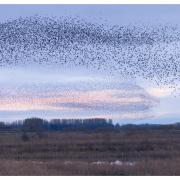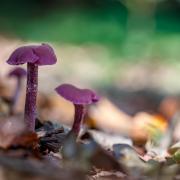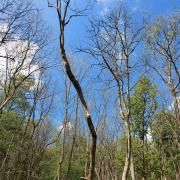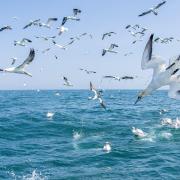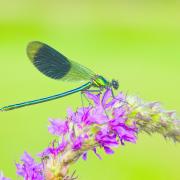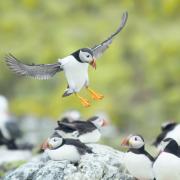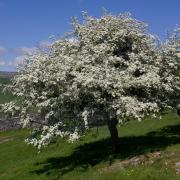Few creatures can claim to have shared the earth with dinosaurs, but our dragonflies were in the thick of the action millions of years ago, just as they are today, as Yorkshire Wildlife Trust’s Tom Marshall reports

More than two decades years after the first Jurassic Park movie roared onto our cinema screens, our obsession with all things dinosaur continues with yet another instalment in the ground-breaking franchise out to scare a whole new audience.
Disappearing as rapidly as the plausibility of the plot in this latest chapter, so too the dinosaurs couldn’t last forever. When you think of the wildlife that can survive whatever cataclysmic event put an end to the dinosaurs’ rule, it’s a pretty tough bunch that springs to mind; sharks, alligators and other deep-sea dwellers usually far beyond our view.
But believe it or not, one of our most delicate and agile insects, dragonflies, were also sharing the skies with pterodactyls – albeit a little larger than the ones you may find in your garden this summer.
The prehistoric ancestors of today’s dragonflies and damselflies in fact had a wingspan in excess of two feet, with a weight heading towards half a kilo, aided by around 10-15 per cent more oxygen in the atmosphere than we make do with nowadays. While these falcon-sized Meganeura were a force to be reckoned with millennia ago, our own dragonflies remain a voracious and feared predator of the pond.

Dragonflies remain one of our largest insects in the UK, however the world’s heaviest insect today, the Goliath beetle, only weighs in at around a quarter of the weight of those dinosaur-age dragonflies. By comparison, modern dragonflies have a wingspan of no more than 19cm and are carrying a lighter load of just a few grams.
Although most of us are familiar with the colourful and vibrant adult dragonflies patrolling our hedgerows and lake edges, it’s the early underwater phase of the dragonfly’s life where it carries its most fearsome reputation.
For anything from a few months to five years, larval or ‘nymph’ dragonflies stalk the murky depths of our waterways in search of a meal, and anything that is unlucky enough to swim past can end up on the menu; from unsuspecting tadpoles to small fish. Extendable mouthparts – which were thought to have inspired another ground-breaking cinematic creature, Steven Spielberg’s ‘Aliens’ – only add to the trepidation for those unlucky enough to pluck one out of a pond for closer inspection.
Eventually though, the time comes to realise their true calling, and over just minutes or perhaps an hour or more, the larvae climb up into nearby vegetation and breathe air for the first time, simultaneously releasing their powerful wings to dry in the sun in readiness for a maiden flight. After so long ruling the depths, these so called ‘teneral’ dragonflies and damselflies find themselves at perhaps the most vulnerable they have ever been, with neither the safety of water or the strength and prowess of flight to rely upon.

Finally, they must make a leap of faith and head out across the water with their dazzling colours and buzzing sorties how most of will recognise these aerial acrobats during the year.
Although we can get a glimpse of the blue and green iridescent hues in the air, the dragonfly’s true beauty is best appreciated when they are at rest. From the azure blues and blood-reds of the damselflies, to the orange and black of the four-spotted chaser, it’s no surprise they were once known as the ‘devils darning needles’.
Ferocious predators of other flying insects, their speed and superb vision enable them to catch mosquitoes, flies, bees, butterflies and even smaller dragonflies, making them no less capable than during their time under the water. With the unpredictable British summer to contend with it’s often a case of eating-on-the-go for many dragonflies, with some of our larger hawkers known to carry prey beneath them in a cage formed by their legs.
Dragonflies don’t get to chalk up many flying hours though, and the two months or less that many of them are on the wing is the final flourishing fraction of their overall lifecycle.
Your guide to Yorkshire’s dragon’s dens
Around two-dozen types of dragonfly breed across Yorkshire, with several others visiting as occasional migrants. A warm, sunny day is best and the margins of pools and ponds being great places to stake-out. The chaser and darter species in particular frequently perch and often favour a particular emerging stick or iris stem, returning to it after chasing off territorial rivals.
Filey Dams
A great stop-off after a day on the coast, the myriad pools and ponds of Filey Dams are dragonfly heaven. Almost 20 species have been seen here including many of our largest and impressive ‘hawker’ dragonflies, and Britain’s smallest, the black darter.
Staveley nature reserve, Boroughbridge
A delightful mix of wetlands, meadows and small pools, Staveley has all a dragonfly could ask for, reflected in the unrivalled list of 22 species of dragonfly and damselfly that have been found here. The lake edges, ditches and dedicated pools are all worth investigating.
Askham Bog, York
The perfect habitat with a rich mix of small acidic pools and vegetation and home to one of the big-hitters of dragonfly world, the emperor dragonfly. An ideal site for beginners looking to kick off their dragonfly adventure just 10 minutes from York city centre.
Potteric Carr, Doncaster
Close to Doncaster, Potteric Carr is one of Yorkshire’s most impressive wetlands and boasts a range of easy-access boardwalks and viewing platforms making dragonfly watching a breeze. Look out for the exquisite banded demoiselle with its shimmering bottle-green wings.
North Cave Wetlands, Brough
Man-made less than a decade ago, but no less impressive for wildlife, North Cave Wetlands is home to an array of specially designed dragonfly pools. Look out for the honey-coloured four-spotted chaser or the sky blue of the broad-bodied chaser, with hobbies a regular late-summer visitor.
For details on all of these sites, plus a huge range of family events and specialist days where you can get up-close to dragonflies and more of the county’s stunning summer wildlife, visit Yorkshire Wildlife Trust’s website at www.ywt.org.uk










